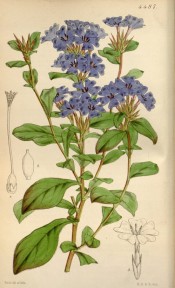Ceratostigma plumbaginoides Bunge
Fully hardy, rhizomatous, spreading, woody-based perennial with upright, slender red stems, obovate, wavy-margined leaves, to 9cm long, colouring in autumn, and terminal spikes of bright blue flowers, to 2cm across, in summer. To 45cm. [RHSE, Hortus].
Horticultural & Botanical History
‘It is a native of China, and was discovered by Mr. Fortune, growing on the ruined ramparts of Shangai; it was subsequently found by Mr. Smith, in the same locality, and also growing out of the stonework of the city wall; but is stated to be, even in its native country, a very rare plant. For its addition to our collections, we are indeobted to the latter gentleman, who sent seeds to Sir George Larpent, by whom it was raised. […] The flowers, as will be seen from the figure, are of a deep rich violet, beautifully tinted in the throat with fine red. The plant also is sufficiently hardy to endure the open air in summer and autumn, so that its real value is greatly enhanced by the use to which it can be appropriated.’ [MB p.267/1847].
‘Although this plant is of but recent introduction, yet its rapid increase by cuttings has made it already very common in the gardens of this country. Owing to some circumstances connected with its introduction and dissemination, its cultivation and its merits as an ornamental flowering plant have been the subject of much discussion with cultivators, perhaps more than it deserves; for although it recommends itself to notice by its pretty blue flowers, yet, considering its relationship and the conditions under which it flourishes in its native country, we do not think it will give satisfaction as an ornamental plant to the generality of cultivators. We learn that it is a native of China, and has been observed as far north as Pekin; but that the plant was found in a wild state on the city walls of Shanghae, “growing out of the stone-work,” and “on the raised ramparts” where it is said to be very ornamental. We naturally presume that a stone wall built by the hand of man is not its original place of growth; but as it has there beome naturalized we may infer that its natural habitat is in dry rocky place subject to great summer heat, and enduring a considerable degree of cold in winter.’ [BM t.4487/1850].
FS f.307/1848. GC p.732/1847. FC p.1/1848.
History at Camden Park
Listed only in the 1857 catalogue [T.766/1857]. Obtained from Veitch’s Nursery, brought out from England by Captain P. P. King in 1849. Believed by Macarthur to be a new introduction at that time. It was also received from Kew Gardens in the same shipment. [ML A1980-3]. Unlike most plants in this importation it did not appear in the 1850 catalogue.
Notes
Published Mar 24, 2009 - 05:14 PM | Last updated Mar 25, 2010 - 02:24 PM
| Family | Plumbaginaceae |
|---|---|
| Category | |
| Region of origin | West China |
| Synonyms |
|
| Common Name | |
| Name in the Camden Park Record | Plumbago Larpentae |
| Confidence level | high |


